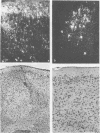Abstract
The pathogenesis of two rodent-adapted strains of measles virus was studied in 1- to 2-day-old suckling and 4-week-old weanling BALB/c mice. Both the mouse-adapted Edmonston (MAEd) strain and the hamster-neurotropic (HNT) strain caused necrotizing giant-cell encephalitis with a 90 to 100% mortality after intracerebral inoculation into suckling mice. After intracerebral inoculation into weanling mice, MAEd virus caused fatal disease in 20% of the mice; HNT virus caused fatal disease in 30%, but an additional 35% of these mice developed disease and then recovered. Even when mice were moribund there was little histological evidence of disease in weanling mice inoculated intracerebrally with either strain of virus. Fluorescent-antibody staining showed extensive measles virus antigen in the suckling mouse brain and focal areas of measles virus antigen in the weanling mouse brain. Infectious virus was recovered easily from the brains of suckling mice by plaquing on Vero cells, but no infectious virus could be recovered similarly from weanling mice. However, virus could be recovered by intracerebral inoculation of weanling mouse tissue homogenates into suckling animals. The immune response appeared to play no role in the recovery from infection or in these age-related differences in disease. It appears that maturation of the cells of the mouse central nervous system converted the production of measles virus from the infectious form in the suckling mouse to a primarily defective infection in the weanling mouse.
Full text
PDF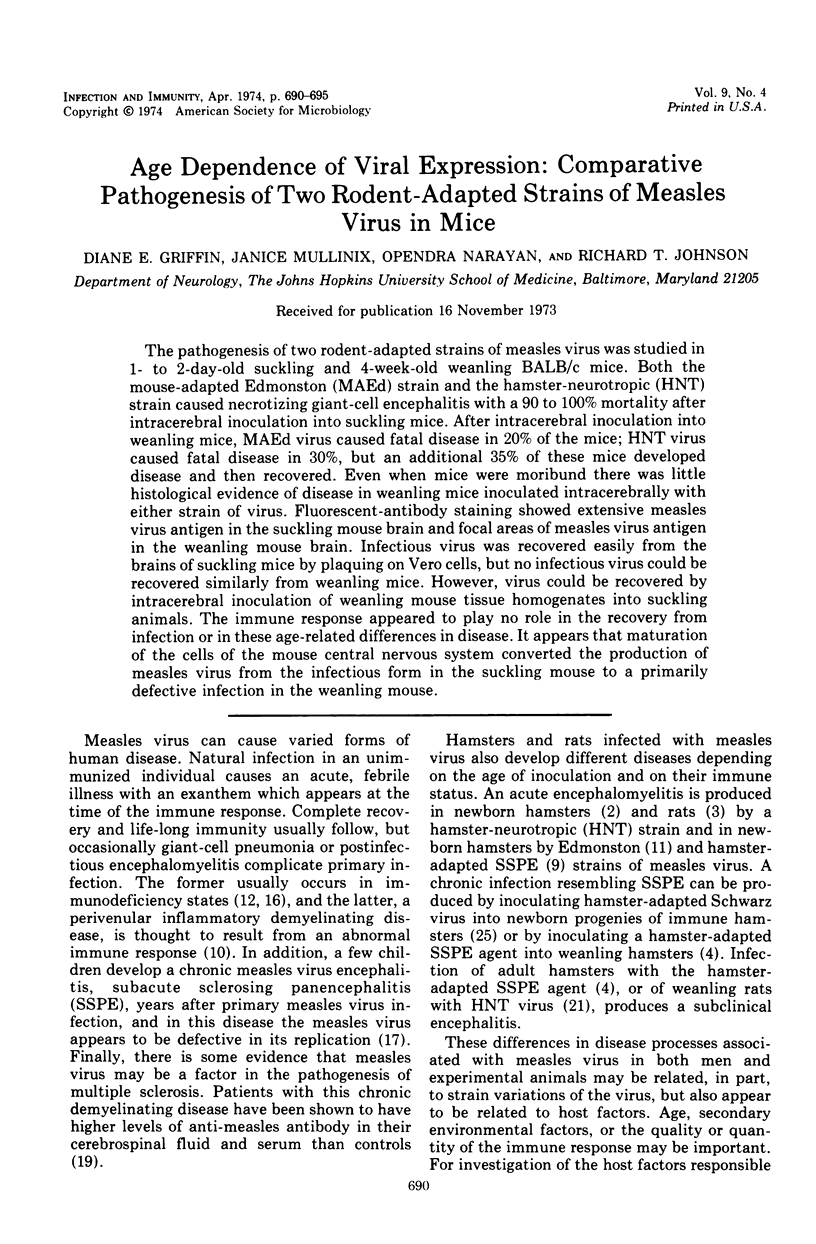
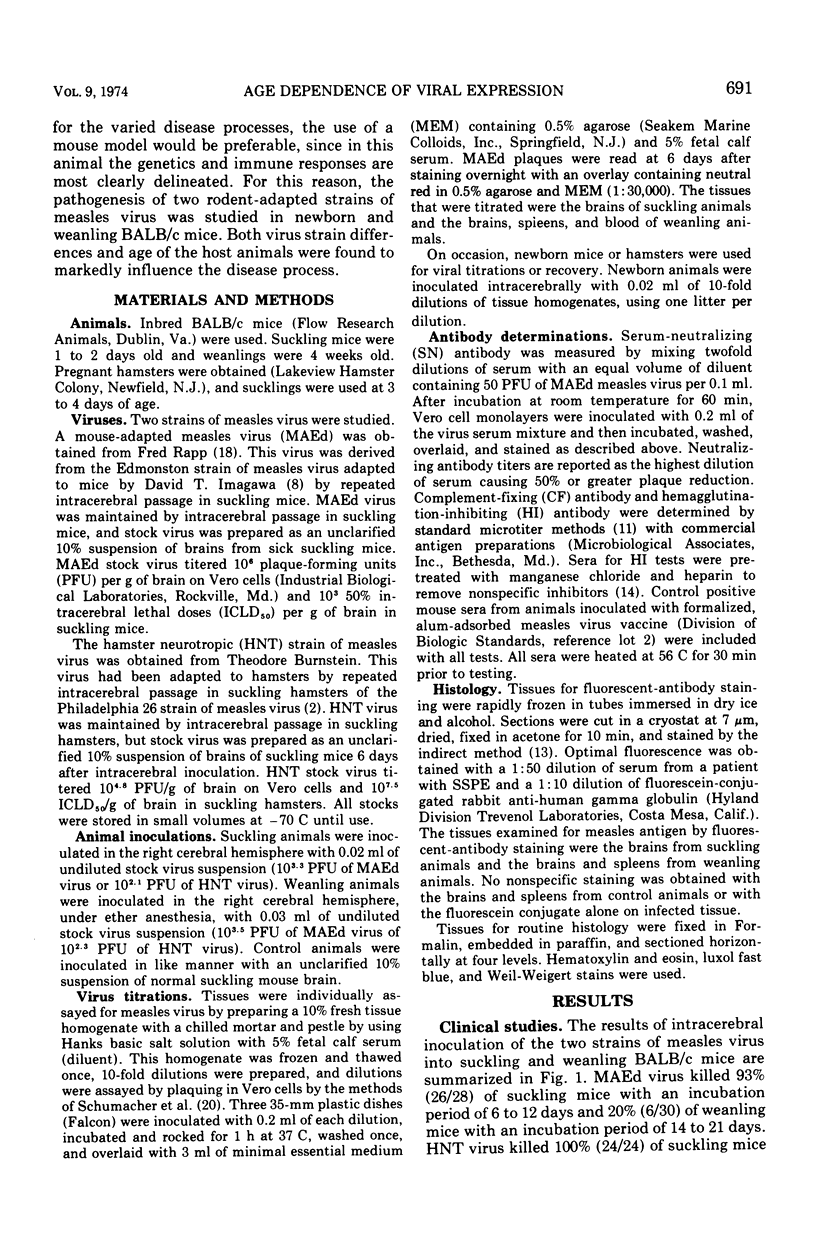
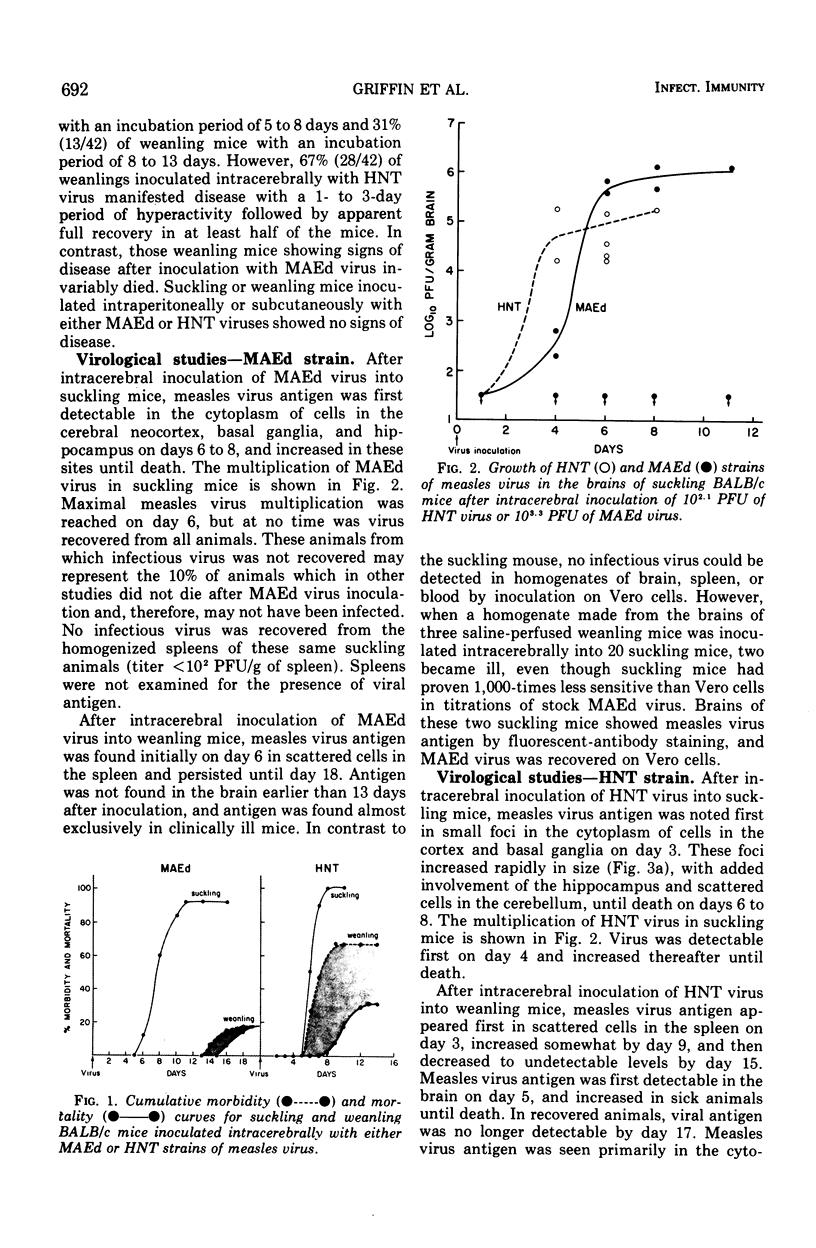
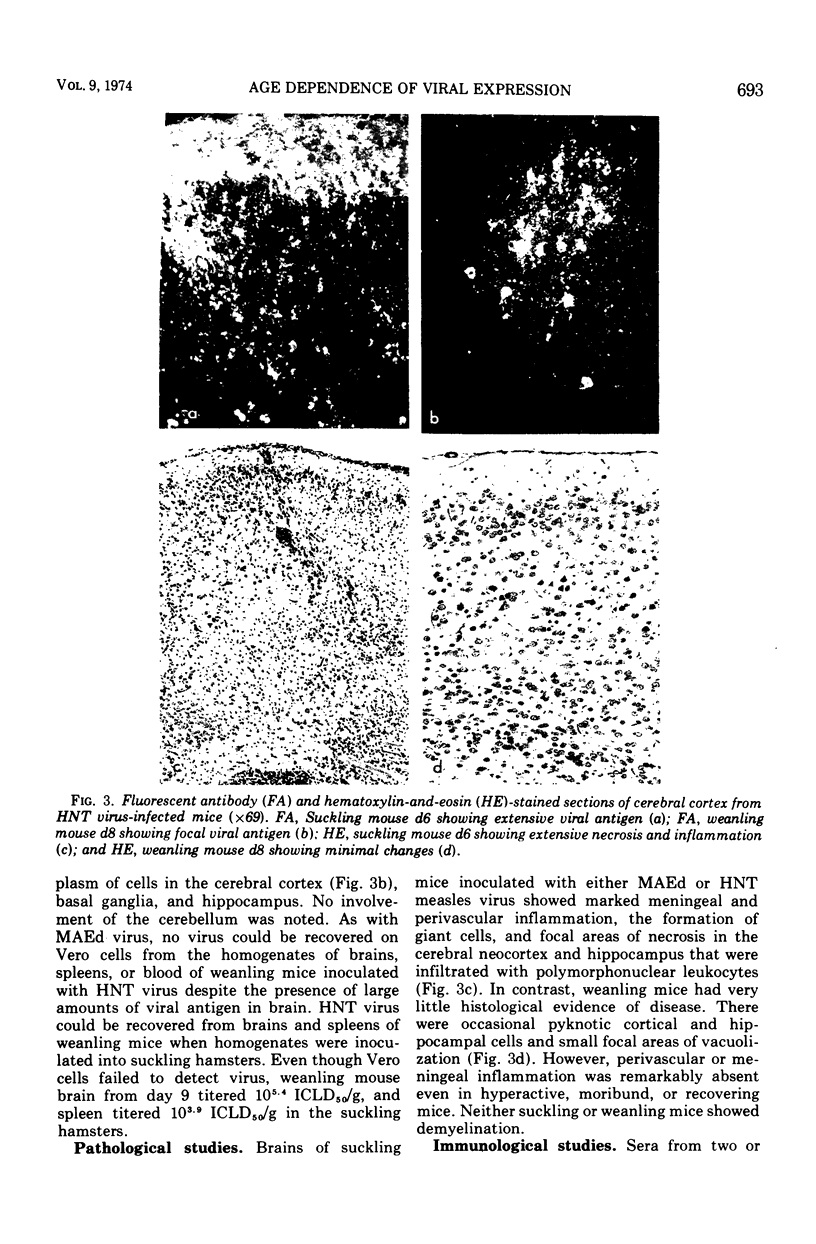
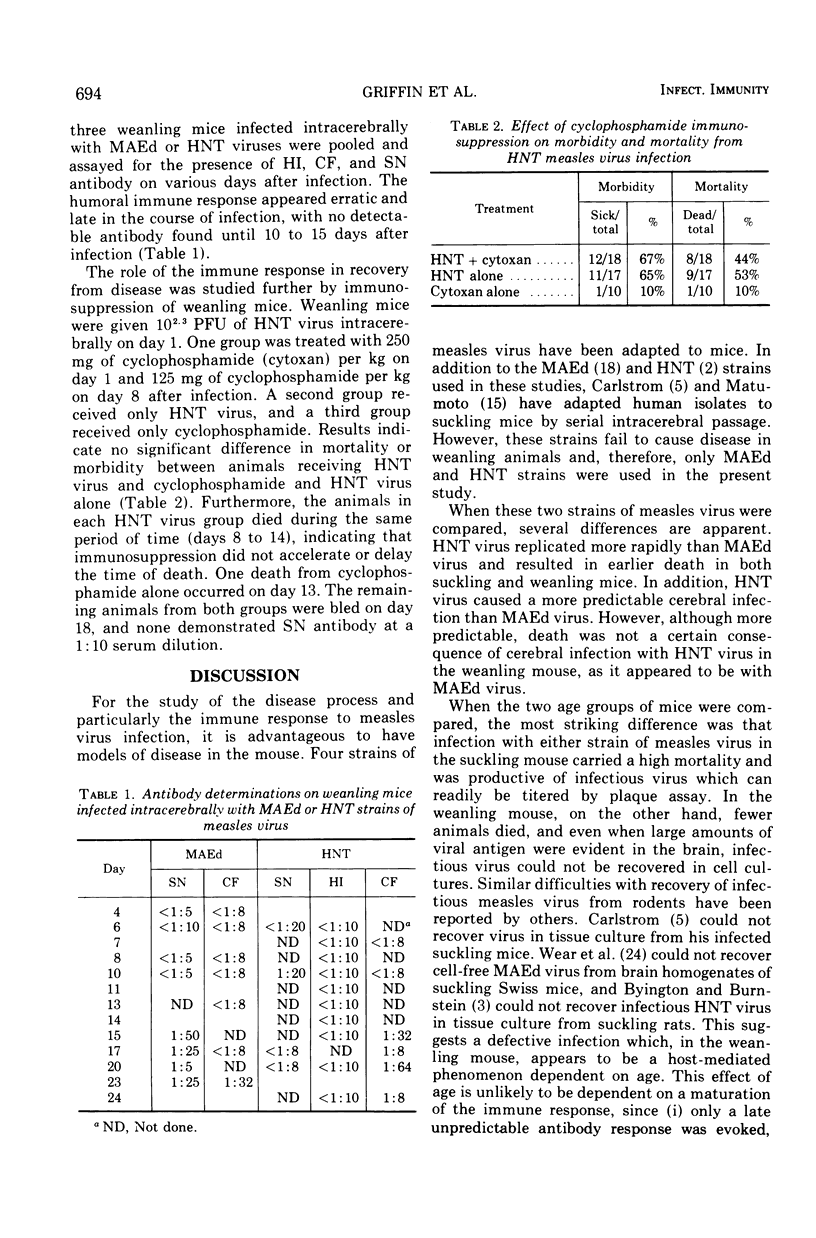
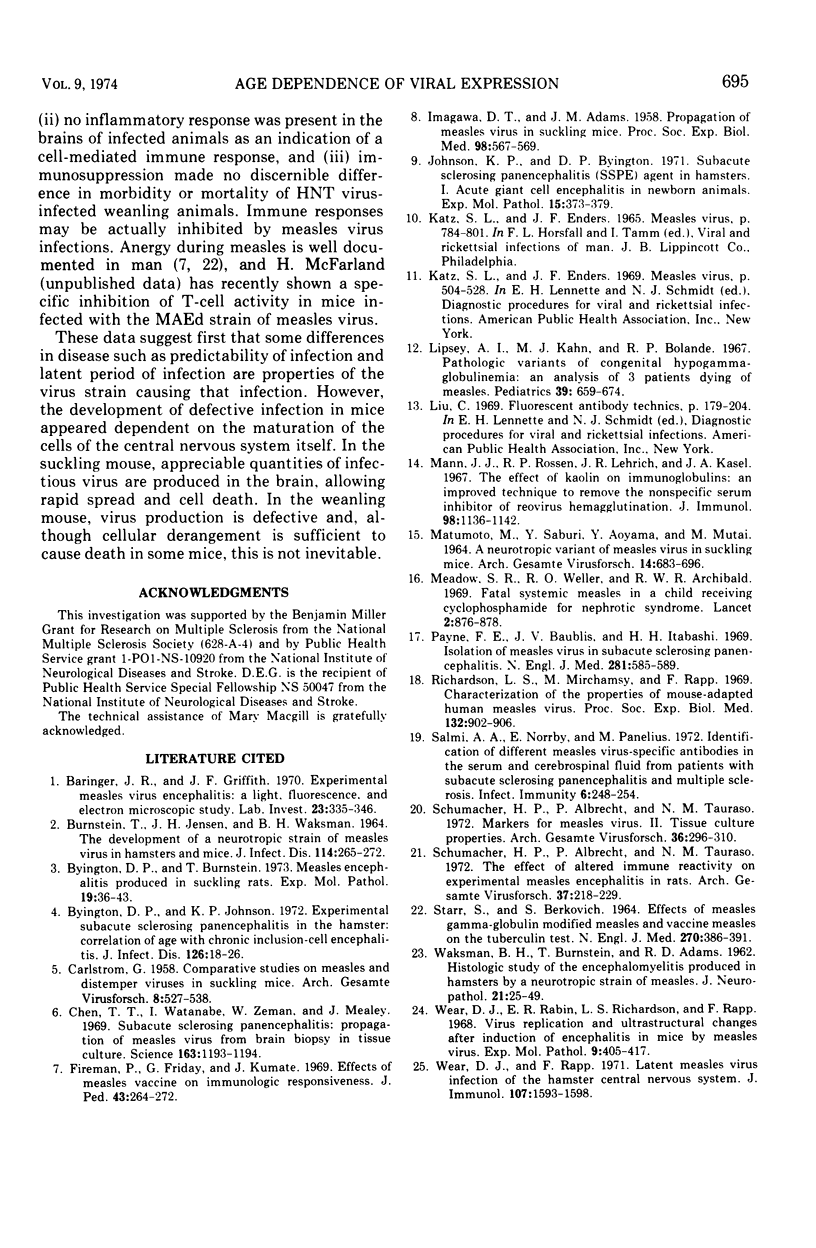
Images in this article
Selected References
These references are in PubMed. This may not be the complete list of references from this article.
- BURNSTEIN T., JENSEN J. H., WAKSMAN B. H. THE DEVELOPMENT OF A NEUROTROPIC STRAIN OF MEASLES VIRUS IN HAMSTERS AND MICE. J Infect Dis. 1964 Jun;114:265–272. doi: 10.1093/infdis/114.3.265. [DOI] [PubMed] [Google Scholar]
- Baringer J. R., Griffith J. F. Experimental measles virus encephalitis. A light, phase, fluorescence, and electron microscopic study. Lab Invest. 1970 Sep;23(3):335–346. [PubMed] [Google Scholar]
- Byington D. P., Burnstein T. Measles encephalitis produced in suckling rats. Exp Mol Pathol. 1973 Aug;19(1):36–43. doi: 10.1016/0014-4800(73)90038-5. [DOI] [PubMed] [Google Scholar]
- Byington D. P., Johnson K. P. Experimental subacute sclerosing panencephalitis in the hamster: correlation of age with chronic inclusion-cell encephalitis. J Infect Dis. 1972 Jul;126(1):18–26. doi: 10.1093/infdis/126.1.18. [DOI] [PubMed] [Google Scholar]
- CARLSTROM G. Comparative studies on measles and distemper viruses in suckling mice. Arch Gesamte Virusforsch. 1959;8(5):527–538. [PubMed] [Google Scholar]
- Chen T. T., Watanabe I., Zeman W., Mealey J., Jr Subacute sclerosing panencephalitis: propagation of measles virus from brain biopsy in tissue culture. Science. 1969 Mar 14;163(3872):1193–1194. doi: 10.1126/science.163.3872.1193. [DOI] [PubMed] [Google Scholar]
- Fireman P., Friday G., Kumate J. Effect of measles vaccine on immunologic responsiveness. Pediatrics. 1969 Feb;43(2):264–272. [PubMed] [Google Scholar]
- IMAGAWA D. T., ADAMS J. M. Propagation of measles virus in suckling mice. Proc Soc Exp Biol Med. 1958 Jul;98(3):567–569. doi: 10.3181/00379727-98-24109. [DOI] [PubMed] [Google Scholar]
- Johnson K. P., Byington D. P. Subacute sclerosing panencephalitis (SSPE) agent in hamsters. I. Acute giant cell encephalitis in newborn animals. Exp Mol Pathol. 1971 Dec;15(3):373–379. doi: 10.1016/0014-4800(71)90044-x. [DOI] [PubMed] [Google Scholar]
- Lipsey A. I., Kahn M. J., Bolande R. P. Pathologic variants of congenital hypogamma-globulinemia: an analysis of 3 patients dying of measles. Pediatrics. 1967 May;39(5):659–674. [PubMed] [Google Scholar]
- MATUMOTO M., SABURI Y., AOYAMA Y., MUTAI M. A NEUROTROPIC VARIANT OF MEASLES VIRUS IN SUCKLING MICE. Arch Gesamte Virusforsch. 1964 Jun 17;14:683–696. doi: 10.1007/BF01555125. [DOI] [PubMed] [Google Scholar]
- Mann J. J., Rossen R. D., Lehrich J. R., Kasel J. A. The effect of kaolin on immunoglobulins: an improved technique to remove the nonspecific serum inhibitor of reovirus hemagglutination. J Immunol. 1967 Jun;98(6):1136–1142. [PubMed] [Google Scholar]
- Meadow S. R., Weller R. O., Archibald R. W. Fatal systemic measles in a child receiving cyclophosphamide for nephrotic syndrome. Lancet. 1969 Oct 25;2(7626):876–878. doi: 10.1016/s0140-6736(69)92330-7. [DOI] [PubMed] [Google Scholar]
- Payne F. E., Baublis J. V., Itabashi H. H. Isolation of measles virus from cell cultures of brain from a patient with subacute sclerosing panencephalitis. N Engl J Med. 1969 Sep 11;281(11):585–589. doi: 10.1056/NEJM196909112811103. [DOI] [PubMed] [Google Scholar]
- Richardson L. S., Mirchamsy H., Rapp F. Characterization of the properties of mouse-adapted human measles virus. Proc Soc Exp Biol Med. 1969 Dec;132(3):902–906. doi: 10.3181/00379727-132-34333. [DOI] [PubMed] [Google Scholar]
- STARR S., BERKOVICH S. EFFECTS OF MEASLES, GAMMA-GLOBULIN-MODIFIED MEASLES AND VACCINE MEASLES ON THE TUBERCULIN TEST. N Engl J Med. 1964 Feb 20;270:386–391. doi: 10.1056/NEJM196402202700802. [DOI] [PubMed] [Google Scholar]
- Salmi A. A., Norrby E., Panelius M. Identification of different measles virus-specific antibodies in the serum and cerebrospinal fluid from patients with subacute sclerosing pancencephalitis and multiple sclerosis. Infect Immun. 1972 Sep;6(3):248–254. doi: 10.1128/iai.6.3.248-254.1972. [DOI] [PMC free article] [PubMed] [Google Scholar]
- Schumacher H. P., Albrecht P., Tauraso N. M. Markers for measles virus. II. Tissue culture properties. Arch Gesamte Virusforsch. 1972;36(3):296–310. doi: 10.1007/BF01249860. [DOI] [PubMed] [Google Scholar]
- Schumacher H. P., Albrecht P., Tauraso N. M. The effect of altered immune reactivity on experimental measles encephalitis in rats. Arch Gesamte Virusforsch. 1972;37(2):218–229. doi: 10.1007/BF01268004. [DOI] [PubMed] [Google Scholar]
- WAKSMAN B. H., BURNSTEIN T., ADAMS R. D. Histologic study of the encephalomyelitis produced in hamsters by a neurotropic strain of measles. J Neuropathol Exp Neurol. 1962 Jan;21:25–49. doi: 10.1097/00005072-196201000-00003. [DOI] [PubMed] [Google Scholar]
- Wear D. J., Rabin E. R., Richardson L. S., Rapp F. Virus replication and ultrastructural changes after induction of encephalitis in mice by measles virus. Exp Mol Pathol. 1968 Dec;9(3):405–417. doi: 10.1016/0014-4800(68)90029-4. [DOI] [PubMed] [Google Scholar]
- Wear D. J., Rapp F. Latent measles virus infection of the hamster central nervous system. J Immunol. 1971 Dec;107(6):1593–1598. [PubMed] [Google Scholar]



